
This is the classic Marantz 2270 receiver in a beautiful wood case. Anyone familiar with vintage audio knows that Marantz built some of the best receivers of the time. And, actually, when restored, probably still stand up against the best out on the market today in terms of sound quality. The 2270 hit the market in late 1971 and retailed for between $500 and $550. It was near the top-of-the-line receiver in the Marantz lineup with the exception of the Model 19 which was still on the market at the time. It’s rated at 70 watts per channel.
The blue dial lighting is an easily recognized feature of most of the 1970’s Marantz receivers. They are also known for their horizontal wheel tuner, which they called the gyro-touch tuner, as opposed to the more common tuning knob. the WC-22 wood case was optional.
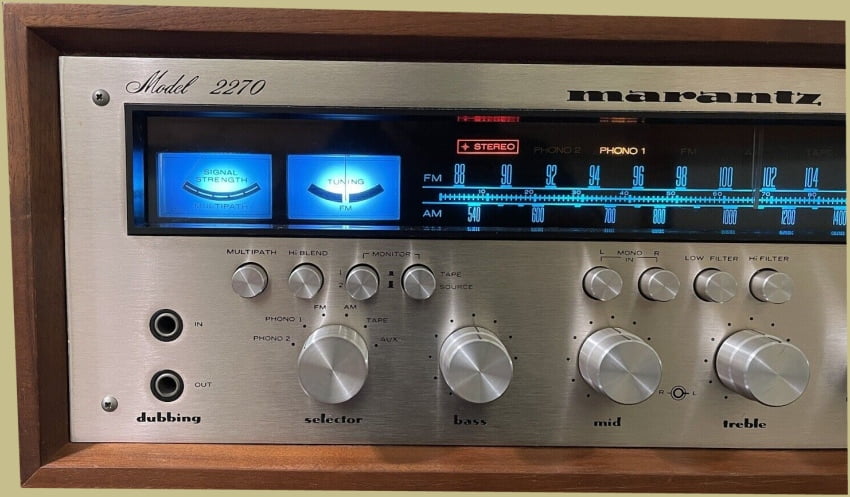
The Marantz 2270 has signal strength and tuning meters backlit with blue light as is the dial scale. The dial indicator needle lights up as well.
Below the tuning meters, dial, and tuning wheel are three groups of switch buttons with four buttons in each group. The first has one button to convert the signal-strength meter to read multipath, a high-blend switch, and two buttons for tape-monitor switching. The second has two for mono-mode switching (permitting selection of left, right, or both signals) and two for filtering – high and low. At the right are buttons for loudness compensation, FM muting, main speakers (on/off), and remote speakers (on/off).
Across the bottom are six knobs: selector, the three tone controls, balance, and volume. At the extreme left are input and output jacks for an added tape recorder. The output is in parallel with the two tape outputs on the back panel; the input overrides those from the back panel. At the extreme right are the power switch and headphone jack, which is live at all times.
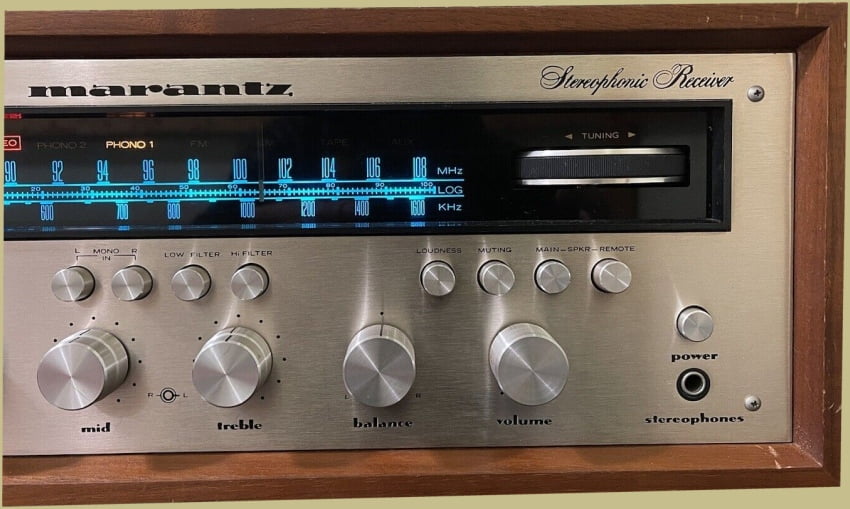
The midrange tone knob makes finer changes than the bass and treble knobs. For most uses, big midrange changes aren’t needed. Turn the midrange knob to make a singer stand out more or blend in if they sound too loud. Basically, it lets you fine-tune the middle frequencies without drastically changing the low and high pitches.
Here’s a comparison of the Marantz models on the market at the time:
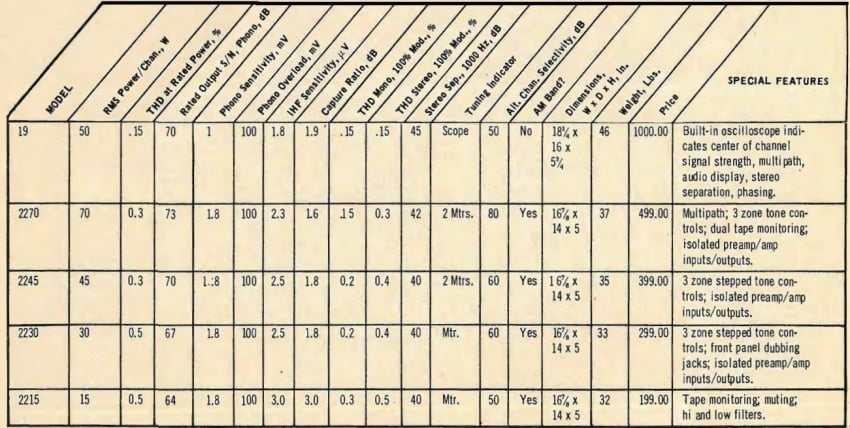
There are a few different versions of the Marantz 2270. Serial numbers for the 2270 production started at 1000. From serial numbers 1000 through roughly 5000 the faceplates had engraved faceplate. Just after serial number 5000 or so (it’s an estimate) Marantz changed to the cheaper method of silk screening the lettering on the faceplate. Also, some portion of the first 4000 units made had a champagne colored face plate. A smaller percentage had a silver face plate (both with engraved lettering). To make it even more confusing, some champagne faceplates had champagne knobs while others had silver knobs and some face plates had a smooth finish while other had a more coarse finish. I think all of the units above serial number ~5000 have a course face plate finish. A few below 5000 have a coarse finish with most having a smooth finish. Most of these differences were due to Marantz engaging in some cost cutting methods.
A few other variations you’ll see are:
Indicator lines on knobs extend to the face of the knob (later version)
Screws vs rivets securing the speaker terminals
Tuning (earlier) vs Gyro-Touch Tuning (later) label above the tuning wheel
Speaker terminals in all black instead of red and black (later version)
The engraved models are fairly rare as only 4000 were made out of a production run of almost 85,000 2270 receivers. The engraved silver version is more rare than the engraved champagne version.
It’s sometimes hard to tell which faceplate color a 2270 has without good lighting or a comparable unit next to it. You can see the difference between the two face plate colors in the picture below.
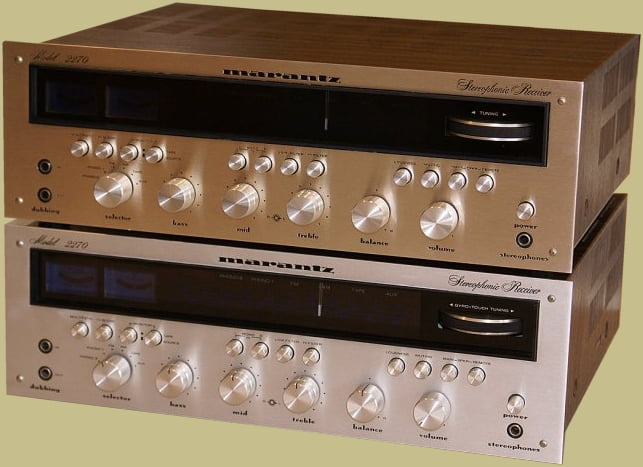
There was also a version with a black faceplate that was sold in Europe.
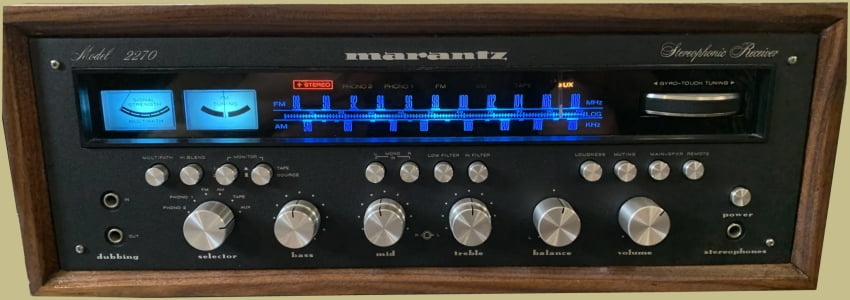
Models in the Marantz lineup at the time included:
- 2215 – 15 wpc for $199
- 2230 – 30 wpc for $299
- 2245 – 45 wpc for $399
- 2270 – 70 wpc for $500
- Model 19 – 100 wpc for $1000
Here’s a famous Marantz advertisement depicting a model 2270 that had survived a fire…
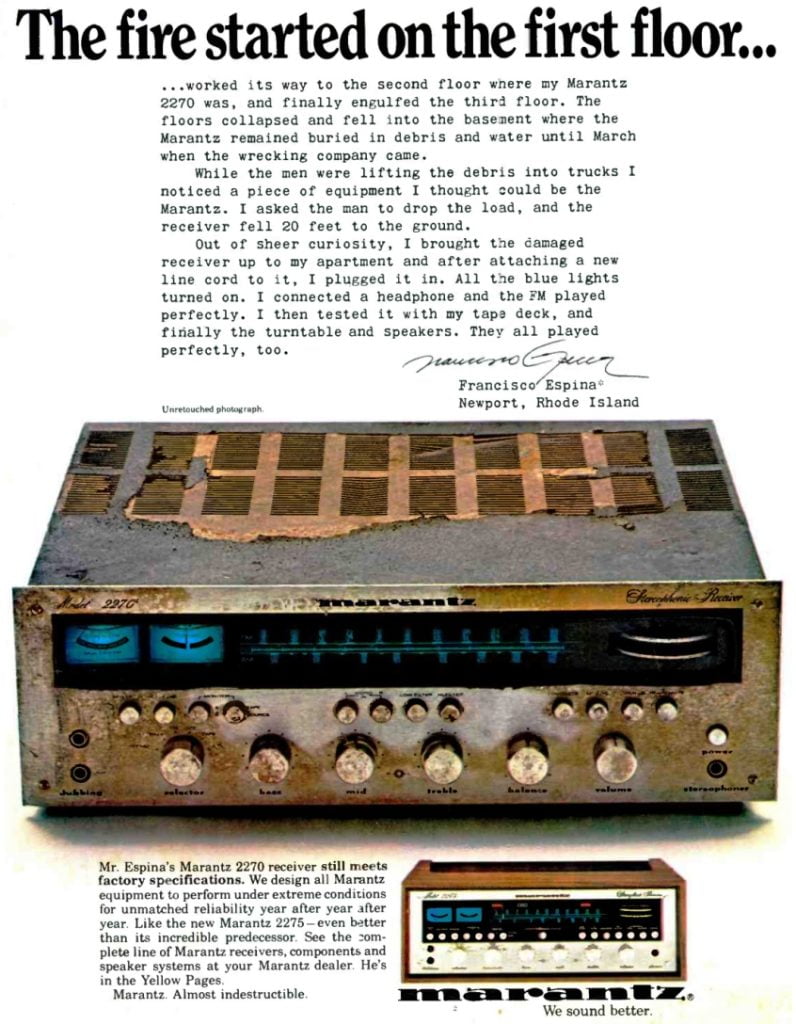
Marantz 2270 specifications:
- Tuning range: FM, MW
- Power output: 70 watts per channel into 8Ω (stereo)
- Frequency response: 7Hz to 50kHz
- Total harmonic distortion: 0.3%
- Damping factor: 45
- Input sensitivity: 1.8mV (MM), 180mV (line)
- Signal to noise ratio: 80dB (line)
- Channel separation: 35dB (line)
- Speaker load impedance: 4Ω to 16Ω
- Dimensions: 17 21/64 x 5 25/64 x 14 inches
- Weight: 38.5 lbs
The tuner in the 2270 is excellent. Quieting descends to -40 dB at only 2.5 microvolts and achieves full effect (-48 dB) at 50 microvolts, making it possible to receive clean sound from stations that would be borderline at best with many receivers. The S/N ratio is more than 79 dB which is excellent and distortion is very low.
Tuner Section
Capture ratio: 2.0 dB
Alternate-channel selectivity: 62 dB
S/N ratio: more than 79 dB
IM distortion: 0.3%

The amplifier section is a delivers ample power. Marantz’s rating of 70 watts per channel is very conservative. In fact, lab measurements at the time rated distortion at no more than 0.1% of either THD or IM compared to Marantz’s rating of 0.3% THD.
Here’s what Marantz said at the time:
Take the new Marantz 2270 stereo AM/FM receiver for $499. It delivers a walloping 140 watts RMS power at less than 0.3% distortion…which means virtually NO DISTORTION… because Marantz measures distortion at continuous full power through the whole listening range. Other companies measure power and distortion only in middle listening range. So they quote their highest power and lowest distortion only in the middle. But on the low and high sides their power is down and their distortion is up. So if you pay for 140 watts be sure you get 140 watts at both ends and in the middle.
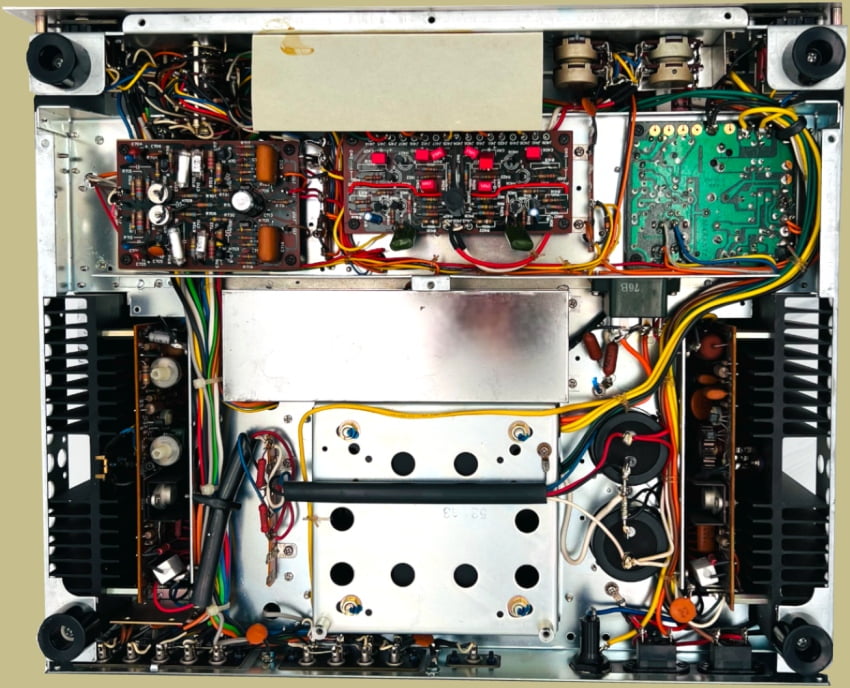
Sometimes the dial scale light will look a little green on a 2270 and that is because Marantz used a type of vellum paper between the bulbs and the dial face. Over time the vellum gets old and brittle and can break apart or turn yellow causing the nice blue light to turn green. Replacing the vellum solve the issue.
On the back panel are the main and remote speaker connections, switched and un-switched AC convenience outlets (one each), a Quadradial output (for use with a quadraphonic broadcast – not likely these days), connections for AM antenna and 75 ohm or 300 ohm FM lead-in, a local/distant FM switch, a screwdriver adjustment for FM-muting level, a chassis ground connection, and the pairs of phono jack inputs and outputs. These include preamp-out and main-in connections that need jumpers for normal use. If the jumpers are missing the receiver will not work. In addition to the inputs and outputs for two tape decks, there are two input pairs for magnetic phono cartridges and one for aux.

You can’t really go wrong with a Marantz 2270 receiver. It has ample power to run most any speaker setup. It has excellent all-round performance as well as an iconic vintage style and values will probably do nothing but go up. If you’ve got the money and want a great receiver then the Marantz 2270 is an easy choice.
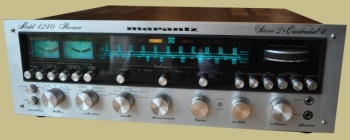

Hi.
Marantz
2215
2230
2270
2470
4230
What’s the difference? 😊
Thanks
The 22 series marantz receivers last two digits are rms wattage. I believe 2470 was a JBL model, and The 4230 is a quad receiver or 4 channel.
I got pro ject carbon turntable and am about to purchase one of these to use with it. What additional pieces am I going to need to be set with a complete system? I was going to get an integrated vintage Marantz amp to make it easier on myself but I want want one of the 2270 volume and quality so I’m going with this. Am I going to have to find an amp? A pre amp? Anything else?
The 2270 has a built in phono amp so you should be good. You can use a preamp if you want but you don’t need one. Not familiar with the pro-ject turntable but as long as it has RCA outputs you should be good.
Hi
I currently have a Project X1 turntable running on my Marantz 2240, 2250, and soon a 2270.
It sounds and works beautifully on the 2240 with no additional preamps or equalizers. I’m running the sound through a pair of vintage Celestion 5 speakers and the sound is simply phenomenal!!
The phono, radio, and a bluetooth adapter for my IPhone song downloads, all sound absolutely amazing through this great combination of vintage and new equipment! Couldn’t be happier. I even bought a pair of vintage Celestion 3’s for a smaller room. Just be careful when you buy older speakers for cracks or tears in the paper or foam. Enjoy!
i have had my 2270 since 1981 it is hands down the best stereo i have ever had.
as far as adding an extra amp…really no need. sound quality is excellent with just the built in ampo and it gets far more than loud enough….trust me. i had a neighbor that lived about a mile away and he could hear my stereo when it was cranked up back in the day. also had a party once and someone turned it almost to max and it blew out the sliding glass door!
I own a 2270,and would like to purchase a wood case for it. Where do I begin this journey?
You can find used cases on eBay. There are also guys that make them new and sell on eBay as well. The 2270 uses the WC-22 case I believe. You can find a list of the current cases for sale on eBay HERE.
Vintage Hi-Fi and Audio has good quality WC’s and better price than on eBay.
https://vintagehifiaudio.com/product/marantz-wc-22-22xx-wood-case/
The article states that production of the 2270 lasted until 1975. I have personally seen at least three units that had late 1976 production dates stamped on their inside frames.
Thanks for the info. Article has been updated.
Marantz was acquired by superscope in the early mid 1970s. The units superscope manufactured were a little shoddy. I owned a 2270 build by Saul marantz and one by superscope. Great receiver
Marantz was acquired by Superscope in 1964.
Just received a Marantz 2270 as a gift from my son. 50 years after I could not afford one while in college. It was worth the wait. The difference over my previous receiver left me speechless. Receiver as refurbished came with original manual and spec book.
This is the perfect vintage receiver. The wood adds elegance to the overall look of the receiver. https://colorviewfinder.co/marantz-2270-review/
Prices for used vintage stereo equipment have gotten way out of hand. People are paying way more than what the stuff is worth.
I think its great that prices are going up, it just means that people want these beautiful receivers that are not made anymore . just like an old electric guitar or a painting . things go up in price. I should of bought 10 of them 10 years ago
Hi,
I own a Marantz 2215. I would like to have same refurbished. Can you recommend a person or company that performs this service. Thanks.